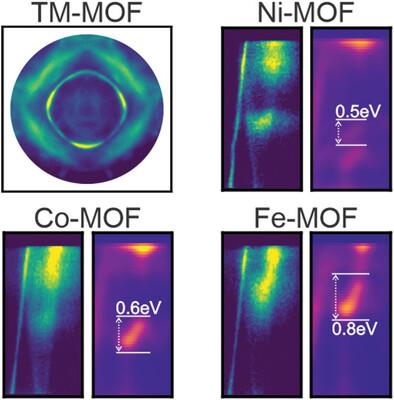Our official English website, www.x-mol.net, welcomes your
feedback! (Note: you will need to create a separate account there.)
Band Structure Engineering in 2D Metal–Organic Frameworks
Advanced Science ( IF 14.3 ) Pub Date : 2024-08-09 , DOI: 10.1002/advs.202404667
Simone Mearini 1 , Daniel Baranowski 1 , Dominik Brandstetter 2 , Andreas Windischbacher 2 , Iulia Cojocariu 3, 4 , Pierluigi Gargiani 5 , Manuel Valvidares 5 , Luca Schio 6 , Luca Floreano 6 , Peter Puschnig 2 , Vitaliy Feyer 1, 7 , Claus Michael Schneider 1, 7, 8
Advanced Science ( IF 14.3 ) Pub Date : 2024-08-09 , DOI: 10.1002/advs.202404667
Simone Mearini 1 , Daniel Baranowski 1 , Dominik Brandstetter 2 , Andreas Windischbacher 2 , Iulia Cojocariu 3, 4 , Pierluigi Gargiani 5 , Manuel Valvidares 5 , Luca Schio 6 , Luca Floreano 6 , Peter Puschnig 2 , Vitaliy Feyer 1, 7 , Claus Michael Schneider 1, 7, 8
Affiliation

|
The design of 2D metal–organic frameworks (2D MOFs) takes advantage of the combination of the diverse electronic properties of simple organic ligands with different transition metal (TM) centers. The strong directional nature of the coordinative bonds is the basis for the structural stability and the periodic arrangement of the TM cores in these architectures. Here, direct and clear evidence that 2D MOFs exhibit intriguing energy-dispersive electronic bands with a hybrid character and distinct magnetic properties in the metal cores, resulting from the interactions between the TM electronic levels and the organic ligand π-molecular orbitals, is reported. Importantly, a method to effectively tune both the electronic structure of 2D MOFs and the magnetic properties of the metal cores by exploiting the electronic structure of distinct TMs is presented. Consequently, the ionization potential characteristic of selected TMs, particularly the relative energy position and symmetry of the 3d states, can be used to strategically engineer bands within specific metal–organic frameworks. These findings not only provide a rationale for band structure engineering in 2D MOFs but also offer promising opportunities for advanced material design.
中文翻译:

二维金属-有机框架中的能带结构工程
2D 金属-有机框架 (2D MOF) 的设计利用了简单有机配体与不同过渡金属 (TM) 中心的不同电子特性的组合。协调键的强方向性是这些架构中 TM 核心的结构稳定性和周期性排列的基础。在这里,直接而明确的证据证明 2D MOF 在金属核中表现出有趣的能量色散电子带,具有混合特性和独特的磁性,这是由 TM 电子能级和有机配体π分子轨道之间的相互作用产生的。重要的是,提出了一种通过利用不同 TM 的电子结构来有效调节 2D MOF 的电子结构和金属芯的磁特性的方法。因此,所选 TM 的电离电位特性,特别是 3d 状态的相对能量位置和对称性,可用于战略性地设计特定金属有机框架内的能带。这些发现不仅为 2D MOF 中的能带结构工程提供了理论依据,而且为高级材料设计提供了有希望的机会。
更新日期:2024-08-09
中文翻译:

二维金属-有机框架中的能带结构工程
2D 金属-有机框架 (2D MOF) 的设计利用了简单有机配体与不同过渡金属 (TM) 中心的不同电子特性的组合。协调键的强方向性是这些架构中 TM 核心的结构稳定性和周期性排列的基础。在这里,直接而明确的证据证明 2D MOF 在金属核中表现出有趣的能量色散电子带,具有混合特性和独特的磁性,这是由 TM 电子能级和有机配体π分子轨道之间的相互作用产生的。重要的是,提出了一种通过利用不同 TM 的电子结构来有效调节 2D MOF 的电子结构和金属芯的磁特性的方法。因此,所选 TM 的电离电位特性,特别是 3d 状态的相对能量位置和对称性,可用于战略性地设计特定金属有机框架内的能带。这些发现不仅为 2D MOF 中的能带结构工程提供了理论依据,而且为高级材料设计提供了有希望的机会。



































 京公网安备 11010802027423号
京公网安备 11010802027423号